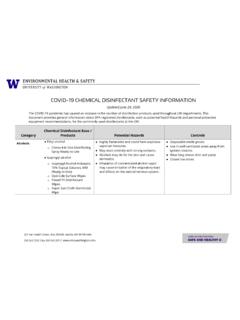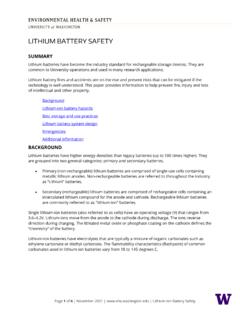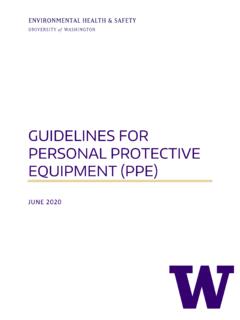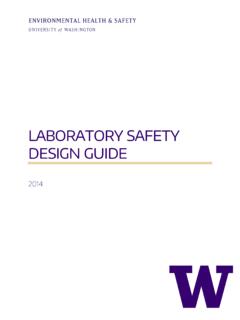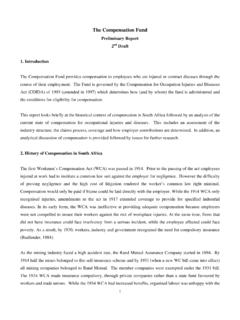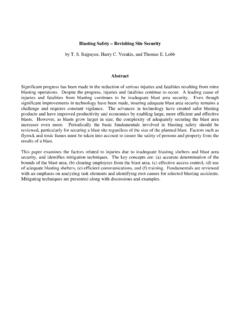Transcription of Laser Safety Fundamentals - EHS
1 UW Laser Safety Manual August 2007 Radiation Safety Office Environmental Health and Safety University of Washington Box 354400 Seattle WA 98195-4400 Phone: FAX: 1 Contents 1. Laser Basics Laser Theory Types of Lasers 2. Hazards and Safety Standards Introduction The Eye Damage to the Eye UV-C and UV-B UV-A Visible and Infrared-A Infrared-B and Infrared-C Symptoms of Exposure The Skin Damage to the Skin Non-beam Hazards Introduction Electrical Hazard Potential Guidelines to Reduce Electrical Hazards Other Hazards Hazard Classes Introduction
2 Class 3B Lasers Class 4 Lasers Safety Standards 3. Laser Safety Responsibilities Introduction Radiation Safety Office Management Research Staff 4. Control Measures Introduction Substitutions Engineering Controls Personal Protection (PPE) Introduction Eyewear Requirements 2 Eyewear Selection Limitations Checklist Administrative Controls 5.
3 Standard Operating Procedures (SOP) Introduction Sample Laser System SOP 6. Alignment Procedures Guidelines 7. Laser Accidents Introduction accident Prevention Examples of Laser Accidents Laser accident Emergency Procedures 8. References Texts Web Sources Laser Terminology Laser Warning Signs Control Measures for the Seven Laser Classes (ANSI) Acknowledgment Thanks to Ken Barat for the use of several photographs and diagrams from his book, Laser Safety Management, 2006. 31.
4 Laser Basics Laser Theory Fig. 1 Electromagnetic Spectrum A Laser (Light Amplification by Stimulated Emission of Radiation) is a device that generates a very intense light beam which is either visible or invisible. Laser light differs from usual white light sources due to three primary characteristics. Laser light is: Monochromatic: is of a single wavelength Directional: has very little beam divergence Coherent: with light waves moving in the same direction and in phase 4 The main components of a Laser are: Lasing Medium (solid state, gas, liquid-dye, semiconductor-diode, or free electron lasers-FELs) Pump Source (Excitation via an electrical source, lamps, lasers, etc.)
5 Optical Cavity Output Coupler Fig. 2 Laser Components Diagram A pump source excites the lasing medium, resulting in an emission of light. In the optical cavity, which contains the lasing medium, there are mirrors at both ends of the Laser causing the emitted light to bounce back and forth. The lasing medium has certain excitation characteristics, which in turn allow for the amplification of the emitted light. The medium determines the wavelength. Some of amplified light then exits through one end of the Laser via the output coupler where one of the mirrors is semi-transparent.
6 The light that exits the Laser may be in a continuous wave (CW) or pulsed. A Q-switch can be included within the optical path which creates very short pulses at high-peak-power. Types of Lasers Laser types are identified by their lasing media (which determines the wavelength). Some media can produce more than one wavelength. Solid state: is an optically clear material composed of a crystal and an impurity dopant. The output wavelength is determined for the most part by the impurity. Examples: Ruby Laser , Nd:YAG. 5 Gas: are very much like fluorescent light sources.
7 An electric current passes through the optical cavity exciting atoms, resulting in the emission of light. Examples: CO2, HeNe, Ar, XeCl, excimer lasers. Liquid (Dye): have a flowing dye and are usually pumped by a flash lamp or another Laser . They can be operated either as pulsed or CW and are wavelength tunable. They tend, however, to be complex systems with demanding maintenance. Semiconductor: is perhaps the most common Laser used currently with output wavelengths in the 750 to 950 nm range (commonly used in CDs and CD/ROM players) or the 1100 to 1650 nm range (used in optical communications).
8 Example: GaAlAs, InGaAsP. Free Electron Lasers (FELs): function via an electron beam in the optical cavity which passes through a wiggler magnetic field. The generated wavelengths are in the microwave and x-ray region. Table 1 Wavelengths of Common Lasers 6 2. Hazards and Safety Standards Introduction The primary concern in Laser Safety is the possibility of eye injury. A secondary one is damage to the skin. Biological effects of Laser light may depend on a number of factors including the wavelength of the light, its power, whether it possesses a continuous wave nature or is pulsed, or whether it is the result of a direct exposure of Laser light rather than a diffuse reflection.
9 Lasers are to be treated with great respect and caution. The Eye Fig. 3 Diagram of the Eye Important components of the eye, such as the cornea, lens, and retina are susceptible to damage by Laser light. Light enters through the transparent layers of the cornea and then is focused by the lens onto the retina. The eye in essence intensifies light energy, particularly the visible and the near-infrared wavelengths, in some cases as much as 100,000 times. For example, if there is a 1 mW/cm2 irradiance of light entered the eye, it can be intensified on the retina 7to an irradiance of 100 W/cm2.
10 The fovea on the retina is a small area (~ 4% of retina) that is responsible for our acute and color vision, so that damage to this portion of the eye can result in a serious loss of sight. Hazards to the eye and skin are summarized below: Table 2 Hazard Effects at Different Wavelengths Damage to the Eye As indicated in Table 2 the area and type of damage to the eye is dependent on the wavelength of Laser light. A more graphic representation is provided below: 8 Fig. 4 Damage Mechanism to the Eye Fig. 5 Photos of Laser Damaged Eyes In the UV-C and UV-B (100-315 nm) range injury can produce photokeratitis (welder s flash).

